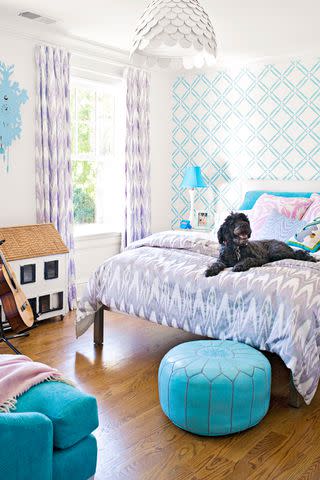Duvet vs. Comforter: What's the Difference?
Learn which option you should snuggle up to with our guide to bed covers.
How do you compare a duvet vs. a comforter? While some people use "duvet" and "comforter" interchangeably, they're designed differently, vary in plushness, and require different care. Duvets come in two separate pieces, an insert and cover, while comforters are one piece of quilted bedding.

Cody Ulrich
Many people choose comforters because they're machine washable and affordable. "A duvet insert or comforter is essentially the base of your bed's top layer. These are typically filled with an insulating material like down or vegan materials that provide warmth and loft, with everything wrapped in a basic shell fabric," says Ruthie Osswald, senior associate of design and product development at Brooklinen.
There are also variations between manufacturers, so even duvets and comforters differ significantly depending on the brand. Knowing the benefits and downsides of duvets vs. comforters will help you make the best choice for your bedding needs.
Related: The 8 Best Comforter Sets for a Cozy Night's Sleep

What Is a Duvet?
The word duvet is derived from the French word for down, a layer of fine feathers found on geese and ducks. Down is soft, fluffy, and warm. This is where duvets get their reputation for coziness. Today, duvets can be filled with alternative materials, like cotton, silk, wool, and synthetic fabrics. A simple cotton or polyester shell encases the filling.
Duvets come with a duvet cover for easy cleaning and more style options. The cover material is usually made of cotton, silk, or linen. A duvet cover can be closed with ties, zips, or buttons that prevent the insert from shifting.
“The inserts to duvets are usually well-made and expensive, meaning cleaning your Cheeto crumbs off of them might be hard or even damaging if not done right since some duvets are stuffed with down feathers,” says Parima Ijaz, founder of bedding company Pure Parima. “Protection is key and washing the duvet cover is a much better option than buying a whole new duvet insert after you decided to drink red wine in bed.”
Most duvets come with special care instructions to prevent damage, but the covers are typically machine washable. Although clumping of the insert material is a common complaint, it can be remedied with tumble drying.
Related: The 6 Best Duvet Inserts of 2023, Based on Testing
What Is a Comforter?
Comforters are designed to be used as-is; they don't need an additional cover. "While both are bed toppers, the biggest difference is that a comforter stands alone," says Amy Hoban, chief creative officer of Parachute. However, comforters may come with a complete bedding set, often called a "bed in a bag." A quilted stitch pattern keeps the filling in place, so there is less clumping. Comforters also tend to be oversized, so they hang over the edge of the mattress more than a duvet.
Comforters tend not to be as warm as duvets but come in just as many colors, patterns, and textures. Although many are machine washable, care instructions vary based on the fill material. To reduce the need for frequent washing, use a top sheet as a sleep barrier. "To best protect your comforter from body oils, sweat, and wear and tear, use it inside a duvet cover—a protective layer that slips over the duvet insert. Duvet covers are available in a range of fabrics, colors, and textures to help match any design aesthetic," says Osswald. For style, purchase coordinating pillowcases or sheets for a cohesive look.
Related: How to Wash a Down Comforter and Other Down-Filled Items

Duvet vs. Comforter: What are the Differences?
The main difference is that a comforter is just one piece, while a duvet is two—an insert and a cover. With a duvet, the insert slides inside the cover, like a pillow that goes inside a pillowcase. A comforter doesn't need a cover, but you can use one to keep it cleaner for longer.
Their fill materials are also often different. Comforters are often filled with synthetic materials, while duvets typically feature high-quality down or feather filling. In addition, duvets indicate the level of firmness or heft they provide, so you can look for specific weights that suit your preferences. Comforters are primarily designed for aesthetic appeal and mass production, so they're typically lightweight. Finally, duvets are usually the same size as the mattress, while comforters are longer.
Related: The 8 Best Duvet Covers of 2023 for Style and Comfort, According to Testing
How to Choose Between a Duvet and a Comforter
Both duvets and comforters are excellent options to keep you warm all year long, but the choice really comes down to aesthetics. A comforter is lower maintenance, but a duvet provides extra thickness and more style options. If you can’t decide which to use, go for the best of both worlds. Protect your comforter with a duvet cover. “A duvet cover is easily removable to wash and switch up the design of your space,” Hoban reminds.
Tips for Creating Your Perfect Sleep Experience
For more Better Homes & Gardens news, make sure to sign up for our newsletter!
Read the original article on Better Homes & Gardens.
